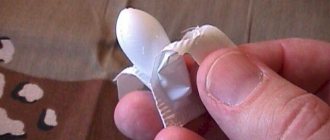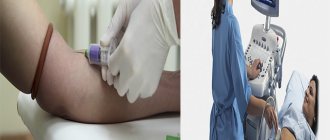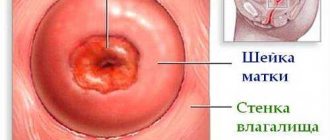After reading the article about the IUD, you will learn:
- 1 What is an IUD?
- 2
Types of intrauterine devices. - 3
The mechanism of action of the intrauterine device. - 4
Why is the intrauterine device compared to abortion? - 5
Indications for insertion of an IUD. - 6
Contraindications for IUD insertion. - 7
Pros and cons of the intrauterine device. - 8
How is an intrauterine device installed? - 9
Possible complications. - 10
Removal of the intrauterine device.
An IUD or intrauterine device is a widespread and fairly effective method of preventing unwanted pregnancy, which involves inserting a special device into the uterus. It is a small device in the form of a spiral (loop, ring) made of plastic, which inhibits the advancement of sperm into the uterine cavity, damages them, reduces the lifespan of the egg, and prevents the attachment of the fertilized egg to the wall of the uterus. Plastic threads are attached to the IUD, which allow the woman to verify that the IUD is in place, and with their help the doctor can easily remove the IUD.
According to the World Health Organization (WHO), the contraceptive effect of the IUD is 98%; on average, when using an intrauterine device, out of 500 women per year, only one becomes pregnant, which is an indicator of the high reliability of this product.
The IUD is installed for several years (from 3 to 10 years depending on the type of IUD) or until the woman wants to remove the IUD, which can be done at almost any time (there are contraindications for removing the IUD). The IUD is inserted and removed by a doctor.
How to install an intrauterine device?
The intrauterine device is installed by an obstetrician-gynecologist in a medical institution.
We'll post the video as usual.
Previously, a woman must undergo an examination and pass the following tests:
- for sexually transmitted infections
- HIV, hepatitis
- flora smear
- scraping from the cervix
- general urine analysis
- Ultrasound of the pelvic organs
If there are no contraindications for the installation of an intrauterine device and the woman is not expecting a child, she makes an appointment with the local gynecologist. The doctor inserts the IUD into the uterine cavity.
For example, Mirena reduces the amount of bleeding during menstruation, thereby preventing the growth of fibromatous nodes on the uterus. In women who have given birth, the uterine cavity is 2 times smaller than in a nulliparous woman, and the cervical canal, on the contrary, is more elongated. In this regard, it is more convenient to install an IUD for women who have already become mothers.
The IUD is introduced in the middle of the cycle. During this period, the antibacterial activity of cervical mucus is maximum, and the risk of rejection and other troubles is reduced.
The surface of the cervix is treated with an anesthetic gel. In extremely rare cases, an analgesic injection may be given. But in general, a woman feels only mild pain, comparable to that which occurs at the beginning of menstruation.
Then it is recommended to lie down. Of course, this is difficult to do in a clinic setting. It is best to take a day off or take time off from work on the day of IUD installation.
Try not to do physical work. In the first week after installation, avoid sex and sports. During this time, spotting and heaviness in the lower abdomen may occur.
The principle of operation of the uterine device
Oral contraceptives (OCs) contain female hormones. They are responsible for the occurrence/non-occurrence of pregnancy. Hormone-containing pills can slow down ovulation. This eliminates the possibility of fertilization.
Contraceptive drugs have an effect on the uterine mucus. It thickens. Because of this, the movement of sperm is significantly hampered: they cannot reach the goal and die without fertilizing the egg. Even if sperm managed to penetrate the fallopian tube, pregnancy still will not occur. Under the influence of hormonal drugs, the lining of the uterus becomes thin. This makes consolidation of the embryo impossible.
There are several types of oral contraceptives. The principle of their “work” is slightly different. But the main thing is that the “target audience” is different. Tablets are divided into:
- combined;
- progestational.
Combined ones contain two types of hormones: estrogen and progestin. Preparations of this type are micro-, low- and high-dose. Tablets with microhormone content are optimal for protecting young nulliparous girls. However, they may not be suitable. Then low-dose drugs are prescribed. This type of COC can be called universal:
Progestogen-type drugs are also called “mini-pills”. These drugs contain one hormone – progestin. Tablets are prescribed if there are contraindications to taking combined (estrogen-containing) drugs. “Mini-pills” also provide protection to nursing women: they do not affect lactation and do not harm the baby.
OKs work well and have many advantages, but they also have disadvantages. Otherwise, the question of choosing between a spiral and pills would not be so pressing. What are the disadvantages of OK? The disadvantages include:
- Features of reception. Oral contraceptives should be taken at approximately the same time every day. If the schedule is disrupted at least once, the likelihood of conception increases.
- Contraindications. Hormonal pills have a number of contraindications. They should not be taken if you have liver problems, kidney pathologies, heart disease, or high blood pressure. If a woman smokes a lot, then she will have to look for another method of contraception. Combination drugs should not be used during lactation, although this fact is balanced by the fact that nursing mothers can take “mini-pills”. Naturally, if they are suitable.
- Side effects. The pills can cause a number of unpleasant symptoms. The beginning of use is almost always accompanied by spotting in the middle of the cycle. OCs can cause headaches, apathy, and decreased libido. Many drugs increase appetite and retain fluid, which can lead to weight gain if you don’t watch your eating habits.
The disadvantages include the fact that OCs lose a large percentage of their effectiveness if a woman takes antibiotics at the same time. Not everyone knows about this, which leads to unwanted pregnancy.
Installation of the IUD is recommended after the birth of the child.
When solving the age-old question “IUD or birth control pills?”, it is important to remember that IUDs are recommended only for women who have given birth. The system can thin the endometrium, which increases the risk of miscarriages in nulliparous women in the future. If complications arise, the woman may be left without offspring.
How does the spiral work? It prevents egg implantation. The foreign body leads to thickening of the uterine tissue, which makes the implantation of the fertilized egg impossible.
Modern copper coils are focused not on an abortifacient effect, but on a spermicidal one. They contain hormones that thicken cervical fluid and suppress sperm activity. The presence of such substances increases the contraceptive effect of the IUD.
The IUD is not inferior in effectiveness to birth control pills, but, like drugs, the system does not protect against sexually transmitted infections. Such contraceptive methods are relevant if you have a permanent partner: only as a way to prevent unwanted pregnancy.
https://www.youtube.com/watch?v=Ss9xtaUI7tQ
All contraceptive methods have their drawbacks. The Navy is no exception. It must be remembered that this method does not exclude the occurrence of infectious diseases. There are other disadvantages:
- If you feel unwell, immediately contact a specialist
High probability of ectopic pregnancy. The IUD operates exclusively within the endometrium; attachment of a fertilized egg can occur outside the uterine cavity.
- It is necessary to control the position of the spiral. Control is carried out independently by thread. Displacement of the IUD significantly reduces its contraceptive effect.
- Unpleasant symptoms after installation. In the first months, menstruation may become heavy.
The spiral is inserted only in a medical facility. The procedure must be carried out by a specialist, but even this is not always a guarantee that the introduction of the spiral will not lead to complications. Among the possible complications, the greatest danger is inflammatory processes and incessant bleeding.
After the procedure, severe pain may occur, and cycle disorders are often recorded. The appearance of pathological signs serves as a reason to remove the foreign body. The spiral cannot be installed in the presence of diseases of the pelvic organs, benign tumors, or discharge of unknown origin.
If we talk about what types of intrauterine devices there are, then this type of contraception is conventionally divided into products with spermicidal and hormonal effects. The basis for the manufacture of intrauterine devices for protection is plastic. Such products have different sizes and shapes, corresponding to the anatomical shape of the intrauterine space.
Each spiral, regardless of type, has an F-shape or a T-shape. The protective principle of operation of the intrauterine device directly depends on its type.
If the contraceptive contains spermicidal components, then upon contact with seminal fluid, sperm destruction will occur, followed by the impossibility of fertilization. Contraceptives that contain a substance of a hormonal nature act on the inner lining of the uterine cavity, thereby disrupting the process of implantation of the fertilized egg into the endometrium.
Before inserting a contraceptive device into the uterus, a medical specialist must make sure that there is no pregnancy or other contraindications to this procedure. This manipulation is performed regardless of the phase of the ovarian-menstrual cycle, but the optimal time is the period from 4 to 8 days of the cycle.
Before a contraceptive device is inserted, a woman undergoes an ultrasound examination of the pelvic organs, and vaginal smears are analyzed for microflora and degree of purity.
The contraceptive is administered on an outpatient basis, without the use of anesthesia. During manipulation, a woman may feel slight discomfort. During the first two days after installation of the product, symptoms such as aching pain in the suprapubic region and discomfort due to contraction of the smooth muscles of the uterus may be felt. In addition, the next two periods may differ in abundance.
If a woman has previously been introduced to a contraceptive, then she is advised to adhere to the maximum use period for the intrauterine device; after this time, the product not only loses its contraceptive properties, but can also threaten the patient’s health.
If a woman has previously had a caesarean section, then installing an IUD to avoid getting pregnant again is allowed at least six months after the operation. The undeniable advantage of this type of contraception is that the intrauterine device can be used during breastfeeding without the risk of harming the newborn baby.
The contraceptive is removed after the product has expired, as well as if any complications develop or at the patient’s personal request. Before removing the IUD, the woman has an ultrasound scan of her pelvic organs to identify the exact location of the contraceptive. Next, a medical specialist uses a hysteroscope to dilate the cervical canal and remove the contraceptive product. If necessary, this procedure can be performed in a hospital setting.
The action of the intrauterine device has two directions:
- a mechanical effect on the epithelium of the uterus, as a result of which changes occur in the structure of the endometrium, and it is impossible for the fertilized egg to attach
- foam formed during inflammatory processes caused by the effect of the coil on the epithelium, reduces the motility and viability of sperm
In addition, copper enhances the contraceptive effect, causing aseptic inflammation in the uterus.
The embryo dies on the 7-10th day of conception. But in most cases, the egg does not even have time to mature. The IUD expands the fallopian tubes, and it moves through them several times faster than usual. As a result, the egg remains immature and unable to conceive.
- Some women are afraid that if you put in a hormonal IUD, you will start to gain weight, your mood will deteriorate and your breasts will hurt. In fact, some changes will be observed in the first 1-1.5 months while the body gets used to it. If they continue further, the spiral must be removed.
- After installation of the IUD, blood loss during menstruation increases. This must be kept in mind. If a woman already has a lot of them, she should opt for hormonal IUDs. On the contrary, they reduce blood flow.
- There are concerns that the IUD may fall out. Yes, this happens, so you need to go to the gynecologist for an examination a month after installation, and then be monitored every six months.
- women are afraid to install an IUD after childbirth. What if this somehow affects breastfeeding? In fact, if the IUD is not hormonal, then the IUD remains almost the only possible method of protection during lactation. It is much more dangerous to use oral contraceptives.
- The intrauterine device is the most effective means of preventing pregnancy
- the spiral does not prevent the walls of the vagina from absorbing hormones and enzymes contained in male sperm
- no need to take pills at the same time every day and worry if you don’t take them on time
- the spiral has a long lifespan
- if the IUD is non-hormonal, it does not cause physiological changes in a woman’s body
- a man does not feel discomfort during sexual intercourse, unlike a condom or ring
- installation of an intrauterine device will not require large financial investments
- When the IUD is removed, a woman can become pregnant quite quickly
Minuses
- there are contraindications for inserting an IUD
- not suitable for nulliparous women
- does not protect against sexually transmitted diseases, so it is not suitable for unmarried women and those who do not have a regular partner
- When wearing the IUD, an ectopic pregnancy may occur
- increased bleeding during menstruation
- If installed incorrectly, the IUD may grow into the uterus
| Manufacturer | Name of the Navy | Cost, rub. | Is it sold in a pharmacy? |
| Bayer | Mirena (hormonal) | 11 500 | Yes |
| Multilan AG | Multiload KU-375 | 3 935 | Yes |
| Schering-Plough | Nova T No. 1 | 2 650 | Yes |
| Gedeon Richter | Goldlily Exclusive | 3 923 | Yes |
| Bayer Pharma AG | Nova T with copper | 2 999 | Yes |
| Simurgh | Juno Juno T Au | 6 500 | Yes |
| SMB | Copper TCu 380A | 650 | Yes |
Ringworm in cats and humans: symptoms, treatment
Girls, remember: ANY contraceptives cause irreparable harm to your body. And not only yours. I will share with you my bitter personal experience, and if this helps at least one of you “decide on the choice of contraception,” then my review was not in vain. My first pregnancy was unplanned, I gave birth to a child at a fairly young age. My gynecologist advised me to immediately put in an IUD shortly after giving birth, because... “The low position of your uterus is conducive to pregnancy.” I considered the spiral to be an ideal contraceptive option, because... I didn’t have to take crap pills, etc. My IUD was also convenient to use; I didn’t have any problems with it, except for heavy periods. I was happy! Especially from the fact that I don’t kill anyone + that I can get pregnant when I want. After the first spiral, I didn’t hesitate to install the second one. As a result, I had two spirals, 5 years each. Now about health. This is my second marriage and, of course, my husband and I wanted to have a child/children together. We have been married for 9 years, but we still don’t have children together. During these 9 years I had an ectopic twice and that’s all. Both were examined; no pathologies were found in either; anatomically, everything was normal in both. A couple of years ago, my husband, during his free time at work, began translating a book about abortion, “The Right to Life,” into German; we live in Germany. One day I got a call from him: “You said you installed a spiral for yourself? How long did you have it? Five years. That's a lot. I’ll bring a book and you can read it...” I lied to him then. I couldn’t admit that I had two for 5 years each... It turns out that they simply HIDE a lot from us - especially information about the consequences, about how conceived embryos die... The worst thing is ignorance. From ignorance of exactly how many souls I ruined with my IUDs.. Having re-read the truthful literature about the intrauterine device, I realized my terrible mistake.. I am writing to you because not a single “medical” institution will tell you such consequences of the intrauterine device as pathology of ectopic pregnancy and infertility. Regarding infertility from IUDs: there are now a lot of infertile couples among young people and there is already an opinion among people that French IUDs for export are impregnated with some substance that leads to infertility.. In conclusion, I would like to remind women who have an unplanned pregnancy, my favorite the proverb “God gave a child, he will give for a child!” And this is not even a saying, but a physical law of life that works 100%, believe me.
They offered me a choice of 2 spirals, Nova for 4700 rubles and Juno for 1500 rubles. The gynecologist says that there is no difference, so why is the price 3 times higher? Maybe someone knows?
They offered me a choice of 2 spirals, Nova for 4700 rubles and Juno for 1500 rubles. The gynecologist says that there is no difference, so why is the price 3 times higher? Maybe someone knows?
Hello. I also want to install a spiral. The doctor recommended copper. Hormonal pills are not very good. I feel bad when taking them. I don’t want to have sexual intercourse and I’m depressed.
Natalya, have you ever tried taking birth control pills? Those for regular contraception? If so, how were you doing with your weight then? And I don’t understand, Mirena is prescribed for contraception or for what?
Girls, my gynecologist advised me to put Mirena on, but I’ve read so much about the side effects - it’s terrible, and weight gain, and baldness, and wild mood swings (like depression) ... I just cured my hair, in 2010 I lost 35 kg, I’m holding on I’m still at this weight, I got married and don’t want to get hysterical with my husband, my character is not angelic anyway, but I don’t need protection. So what should I do? How to make the right decision?
How to remove a spiral?
The intrauterine device resembles the shape of the letter “T” with antennae at the bottom.
The spiral itself will be pulled out for them. The process of removing it is painless in most cases, but the woman most often experiences discomfort.
The woman lies down on the gynecological chair, the doctor inserts a speculum into the vagina to see the cervix. It is treated with an antiseptic. Then, using forceps and other auxiliary instruments, the gynecologist will try to “grab” the antennae and pull the spiral out of the uterine cavity.
If for some reason this cannot be done, removal will be carried out using a hysteroscope.
conclusions
Reviews from medical specialists and women who have previously used this method of contraception are varied. This method of protection against the onset of unplanned pregnancy is effective and safe only in the absence of contraindications, as well as if the technique of inserting the device into the uterine cavity is followed.
If we talk about whether a man feels the presence of a spiral in a woman during sex, then subtle discomfort may occur in a partner if the head of the penis comes into contact with the antennae of the spiral located in the cervical area.
Before making a choice in favor of this product, it is recommended to evaluate the balance of benefits and possible harm from using the spiral with hormonal and non-hormonal components.
Pros and cons of using an intrauterine device
Oral contraceptives have many advantages, thanks to which they have gained such enormous popularity. The advantages of such funds include:
- You should not take hormonal pills on your own, it can be dangerous.
High reliability. The pills prevent pregnancy by 99 percent.
- Versatility. OK can be used at any age: each age group has its own medications, which a gynecologist will help you choose.
- Stabilization of hormonal levels and the menstrual cycle. The tablets normalize hormonal levels, relieve severe symptoms of PMS, stabilize the cycle, and eliminate menstrual pain. An additional bonus is improved skin and hair condition.
- Reducing the risk of developing diseases. OCs prevent the development of tumor-like formations in the reproductive organs and endometriosis.
- Do not affect reproductive function. You can stop using protection at any time (of course, it is better to consult your doctor first). After stopping the medications, the possibility of conception resumes almost immediately.
This method of contraception is considered the most reliable of all available, and its effectiveness is 99.9%.
Moreover, the woman simply did not notice that her spiral had fallen out. And it falls out in those who have just given birth to a child, and in nulliparous women due to the wider passage of the cervical canal.
Combining these two methods of contraception increases the inability to conceive up to 100%.
If the IUD is installed correctly, then after its removal a woman can become pregnant within a year. In addition, many women have noted the positive psychological effect of using an intrauterine device.
Unlike oral contraceptives, the IUD does not require any restrictions or daily monitoring. She also doesn’t feel like a man at all. The silver intrauterine device not only protects against unwanted pregnancy, but also reduces the risk of inflammatory processes in the pelvis.
Minuses
Reviews about the use of the IUD
Of course, before you start using a contraceptive such as an intrauterine device, the pros and cons, reviews and recommendations of the doctor must be taken into account.
So, after reading the reviews of women about the use of IUDs, several conclusions can be drawn.
Even more interesting:
Effective injections for prostatitis
Is duphaston a hormonal drug?
There are many positive reviews that the menstrual cycle improves and often becomes much shorter. For many people, their intimate life with their partner improves, since there are no special requirements for the spiral, it is easy to use, does not feel, and does not cause discomfort.
Many emphasize the importance of choosing the right size, so that it does not fall out or move, as well as in its composition. So, copper may not be suitable or vice versa. They note the importance of the fact that the procedure for installing or removing the spiral should be performed by a competent, experienced gynecologist. Only in this case it is practically painless. They also emphasize the need for regular examinations and timely removal of the coil to avoid complications such as ingrowth or the development of an infectious process. And before installation, a thorough examination and treatment of existing diseases is necessary. Without this, there can be serious health problems, including loss of the uterus.
Economical, affordable and effective, yet the intrauterine device provides a 95% guarantee against pregnancy. Each category of patients has its own pros and cons.
Negative reviews, on the contrary, note prolonged menstruation, but painless, constant discharge. There are also many reviews about pregnancy occurring when using an intrauterine device. It is believed that if you have a family history of genital cancer, then installing the IUD is a big risk. For some, the spiral does not take root.
I would like to note that all reviews emphasize that this type of contraception will be an effective means of protection only if all the pros and cons of the intrauterine device are taken into account, and all issues are discussed with a gynecologist who has sufficient experience and level of knowledge.
Protection against unwanted pregnancy will help avoid problems and preserve the woman’s health. Do not let this process take its course in the hope that it will pass; it is better to play it safe and enjoy intimacy with your loved one.
Contraception is one of the most exciting issues in every woman’s adult life. There are many ways to protect yourself from unwanted pregnancy. One of the reliable protection options recommended by gynecologists is an intrauterine device (IUD). How painless the IUD installation procedure itself is and how long it lasts are no less important questions for women who decide to choose this method of contraception.
Side effects
Despite all the delights of the intrauterine device and its effectiveness, we should not forget that it is, first of all, a medication, and it has its side effects. Among them:
- the risk of infection in the uterine cavity increases
- The amount of bleeding during menstruation increases significantly
- If the uterus is not installed correctly, a woman may experience pain in the lower abdomen
- the non-hormonal IUD does not protect against ectopic pregnancy
- After removal of the IUD, it is necessary to use a condom for the first 3-4 months, because there is a risk of ectopic pregnancy
- the IUD does not protect against sexually transmitted infections, so it is not suitable for women who do not have a regular partner
Before using this method of family planning, it is important to remember that this female contraceptive may cause complications. Such complications include:
- Chronic pain syndrome in the lower abdomen.
- Traumatic damage and perforation of the uterine walls.
- Uterine bleeding.
- Development of an infectious-inflammatory process.
In addition, the female IUD does not protect 100% from pregnancy, so any woman is at risk to one degree or another. If a woman becomes pregnant with an intrauterine device installed, her risk of developing an ectopic pregnancy increases. In addition, the likelihood of getting pregnant even with the IUD increases if the contraceptive was initially introduced in violation of its installation technique.
In some situations, the product may grow into the uterine wall or spontaneously fall out under the influence of external or internal factors.
If a woman is undergoing a magnetic resonance imaging procedure, then doing an MRI with a coil in the uterine cavity is highly not recommended, since during the diagnostic process there is a possibility that the contraceptive will heat up. In this situation, you should think about early removal of the contraceptive.
Classification by composition
Depending on what materials the intrauterine contraceptive is made of, there are inert, metal-containing (copper, silver, gold) and hormone-containing devices.
Inert contraceptive devices belong to the first generation and are considered an outdated option. They are characterized by low efficiency and have a high risk of displacement and even loss. They are made of plastic and do not contain any additives, i.e. neutral (inert). The contraceptive effect of these IUDs is reduced to creating obstacles to the implantation of the fertilized egg and provoking aseptic inflammation. This type is banned in many countries due to the low contraceptive effect and the high likelihood of various complications. Among the most famous representatives of this group are the Lips loop, the Mauch steel ring, the Saf-T-Coil and the Dalkon shield.
Metal-containing IUDs belong to the second generation. Contraceptive coils made of copper are small in size. The rod of such a device is entwined with copper wire, which allows you to create an acidic environment in the uterine cavity, which significantly slows down the activity of sperm. This product is installed for a period of 3 to 5 years. Birth control devices containing silver have been developed as an alternative to copper and have a longer lifespan (5 to 7 years). In addition, silver ions have antibacterial and disinfectant properties and have a beneficial effect on women’s health. IUDs with the addition of gold are characterized by absolute biological compatibility with the woman’s body, the absence of allergic reactions and inflammation, and resistance to corrosion. They are installed for a period of 5 to 10 years. The contraceptive effect of such spirals reaches 99%. The most popular models are Multiload, Nova T, NovaPlus, Juno Bio, T de Oro 375 Gold and Para Grand.
Hormone-containing IUDs belong to the third generation. They contain the hormone progesterone. According to doctors, these spirals are the most effective. They have no contraindications. Hormones have only a local effect and do not enter the blood, slowing down ovulation and preventing fertilization. In addition, hormone-containing IUDs not only prevent conception 100%, but also have a therapeutic effect - they relieve inflammation. Therefore, they are recommended for women with uterine fibroids or endometrial hyperplasia. Such spirals are installed for 5–7 years. The most famous hormone-containing IUDs are Mirena and Levonova.
Read also: How is an IUD installed?
Can I take birth control pills while breastfeeding?
How to quickly dry jeans after washing?
Benefits of the IUD
The IUD is a popular method of contraception. Women choose it because of its numerous benefits. The advantages of the IUD include:
- High efficiency. Installation of an intrauterine system eliminates conception by 95–97%.
- Long lasting. Contraception will allow you to forget about the worries associated with an unwanted pregnancy for three to five years.
- Cost-effective and convenient. IUDs, unlike pills, do not need to be purchased regularly or follow any schedule. In fact, after installation you can forget about the presence of the system.
- Action without conventions. The spiral does not interact with medications, that is, a high level of protection is maintained regardless of the circumstances.
- Does not affect reproductive function in the future. If no complications arise after installation of the IUD, reproductive function resumes immediately after removal of the system. True, the body often needs time to recover.
The IUD can be considered as a postpartum method of contraception. It does not affect lactation, so it is suitable for nursing mothers. The contraceptive system can be installed six weeks after delivery, provided that the birth was not accompanied by complications. Only a gynecologist can determine the possibility of installation.
Pregnancy with an IUD installed
The use of an intrauterine device provides an almost 100% guarantee against pregnancy during its service life. However, the risk is still present and is most likely in cases of expiration, incorrectly installed coil or its displacement.
In gynecological practice, although it is rare, pregnancy is diagnosed when an IUD is installed without signs of displacement, incorrect installation and when its service life has not yet expired. Gynecologists find it difficult to explain why fertilization occurs in such cases. Pregnancy that has occurred while using the IUD can be recognized by the usual signs:
- delay of the next menstruation;
- nausea and (or) vomiting;
- chest pain and increase in size;
- increased level of hCG in the blood.
It is important to understand that the signs of intrauterine and ectopic pregnancy are the same. When an IUD is installed, the latter occurs more often. Treatment occurs by removing the fallopian tube in which the embryo was attached. In the future, this reduces the likelihood of getting pregnant by half. In any case, if there is a suspicion of pregnancy, the woman should immediately consult a doctor to confirm or exclude this fact. Even if the embryo is attached to the wall of the uterus, it may be mechanically damaged by the spiral. Therefore, the gynecologist should monitor the course of pregnancy, taking into account the presence of the IUD, and often prescribe ultrasound examinations.
There are often cases when the IUD, injuring the walls of the uterus, provokes its contraction, which leads to miscarriage. There are also situations when the spiral prevents the growth of the embryo. Depending on the clinical picture, the doctor decides whether it is necessary or impossible to remove the coil. Each case is individual. Many women who became pregnant with an IUD went through their entire pregnancy with it and gave birth to healthy children.
What's better?
When choosing a contraceptive method, it is important for a woman to know which one is the safest, most effective, and most economical. Only a gynecologist can find out which is better; IUDs or birth control pills have their pros/cons for each specific case. The doctor selects the method of protection individually. When choosing a contraceptive method, the following are taken into account:
- health status;
- presence of contraindications;
- age;
- presence/absence of pregnancy history.
It should be remembered that nulliparous women are extremely rarely given the IUD. Doctors dissuade patients from such an undertaking, arguing the possibility of infertility as a result of uterine deformation. Therefore, the choice for women who have not yet experienced the happiness of motherhood is obvious - oral contraceptives. They should not be taken without prior consultation with a gynecologist.











